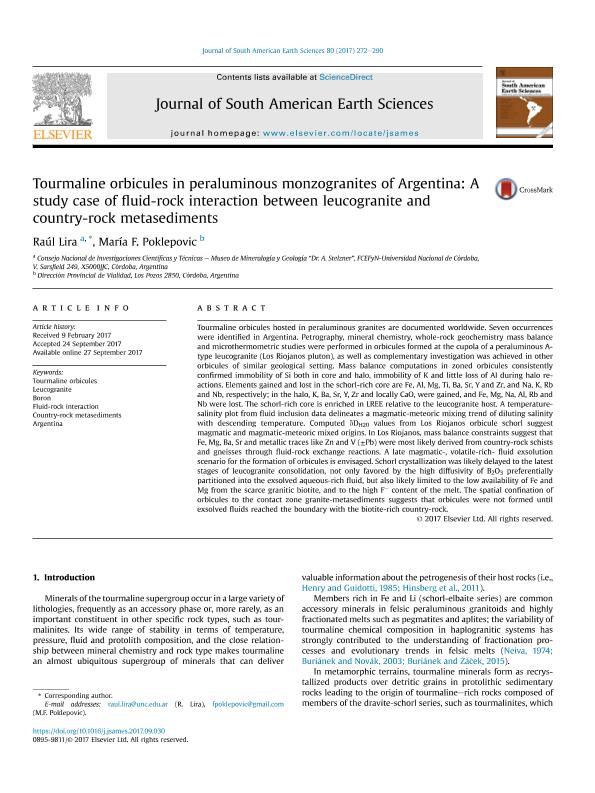Artículo
Tourmaline orbicules in peraluminous monzogranites of Argentina: A study case of fluid-rock interaction between leucogranite and country-rock metasediments
Fecha de publicación:
12/2017
Editorial:
Pergamon-Elsevier Science Ltd
Revista:
Journal of South American Earth Sciences
ISSN:
0895-9811
Idioma:
Inglés
Tipo de recurso:
Artículo publicado
Clasificación temática:
Resumen
Tourmaline orbicules hosted in peraluminous granites are documented worldwide. Seven occurrences were identified in Argentina. Petrography, mineral chemistry, whole-rock geochemistry mass balance and microthermometric studies were performed in orbicules formed at the cupola of a peraluminous A-type leucogranite (Los Riojanos pluton), as well as complementary investigation was achieved in other orbicules of similar geological setting. Mass balance computations in zoned orbicules consistently confirmed immobility of Si both in core and halo, immobility of K and little loss of Al during halo reactions. Elements gained and lost in the schorl-rich core are Fe, Al, Mg, Ti, Ba, Sr, Y and Zr, and Na, K, Rb and Nb, respectively; in the halo, K, Ba, Sr, Y, Zr and locally CaO, were gained, and Fe, Mg, Na, Al, Rb and Nb were lost. The schorl-rich core is enriched in LREE relative to the leucogranite host. A temperature-salinity plot from fluid inclusion data delineates a magmatic-meteoric mixing trend of diluting salinity with descending temperature. Computed δDH20 values from Los Riojanos orbicule schorl suggest magmatic and magmatic-meteoric mixed origins. In Los Riojanos, mass balance constraints suggest that Fe, Mg, Ba, Sr and metallic traces like Zn and V (±Pb) were most likely derived from country-rock schists and gneisses through fluid-rock exchange reactions. A late magmatic-, volatile-rich- fluid exsolution scenario for the formation of orbicules is envisaged. Schorl crystallization was likely delayed to the latest stages of leucogranite consolidation, not only favored by the high diffusivity of B2O3 preferentially partitioned into the exsolved aqueous-rich fluid, but also likely limited to the low availability of Fe and Mg from the scarce granitic biotite, and to the high F− content of the melt. The spatial confination of orbicules to the contact zone granite-metasediments suggests that orbicules were not formed until exsolved fluids reached the boundary with the biotite-rich country-rock.
Archivos asociados
Licencia
Identificadores
Colecciones
Articulos(CCT - CORDOBA)
Articulos de CTRO.CIENTIFICO TECNOL.CONICET - CORDOBA
Articulos de CTRO.CIENTIFICO TECNOL.CONICET - CORDOBA
Citación
Lira, Raul; Poklepovic, María Fernanda de Los Ángeles; Tourmaline orbicules in peraluminous monzogranites of Argentina: A study case of fluid-rock interaction between leucogranite and country-rock metasediments; Pergamon-Elsevier Science Ltd; Journal of South American Earth Sciences; 80; 12-2017; 272-290
Compartir
Altmétricas




